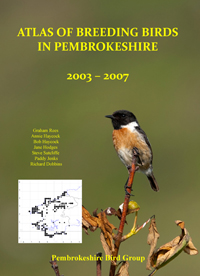Swift - 1994
 Thursday, December 22, 2011 at 11:09PM
Thursday, December 22, 2011 at 11:09PM Breeding summer visitor and passage migrant. Not recorded from November to February
Mathew (1894) regarded the Swift as a summer visitor, local but numerous in places, and noted breeding on inland crags. Lockley et al. (1949) called it a numerous summer visitor breeding in castles, chapels and tall buildings.
Although the majority of today's Swifts breed in buildings, natural sites are used in the cliffs at Stackpole Head, St Govan's Head and Stack Rocks (Flimston), as were others at Linney Head and Caldey Island in the past. The availability of man-made sites must be limiting, and an upsurge in building renovation in recent years, as well as the construction of new buildings that do not permit access to Swifts, makes it probable that they are less numerous than they used to be. Assessing the size of the population is problematical as their nests are not readily visible. Some idea can be gained by watching how many enter buildings or by noting the numbers screaming around the colonies during calm evenings. Using such methods, it is evident that considerable numbers breed in towns such as Tenby and Haverfordwest, that they are less numerous in other towns such as Fishguard and Narberth and that smaller colonies exist in pockets, as at Wiston Church, Gelly and Boncath. Linking rough estimates of this kind with the Breeding Birds Survey, the total population seems to be of the order of 2,000 pairs, but this may well prove to be an underestimate.
The first Swifts usually arrive in April, with the bulk following in May. Earlier birds have been seen from 14 April, and six were at Orielton on 21 March 1960 and one at Skokholm on 26 March 1953. They continue to pass northwards throughout May and into June. One was seen against the lantern of the Smalls lighthouse on the night of 17 May 1984.
It is difficult to decide whether the Swifts seen over the offshore islands in July are migrants or feeding birds from mainland colonies. Those found dead from collision with the lantern of the South Bishop lighthouse at night in July might indicate passage, but they could have been locally breeding birds which were asleep on the wing when forced down by bad weather. Swifts depart the colonies suddenly and en masse during the first three weeks of August, when they can also be seen flying in off the sea along the north and west coasts, and they were recorded killed at night at the South Bishop lighthouse on 6 August 1975 and 25 August 1976. A few are seen in September with occasional stragglers into October, the latest recorded being on 28 October.

Fieldwork 1984-88 (based on 478 tetrads)
Red = breeding confirmed = 89
Orange = breeding probable = 11
Total tetrads in which registered = 100 (20.9%)


Reader Comments